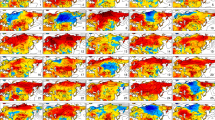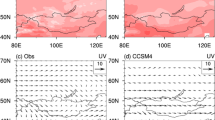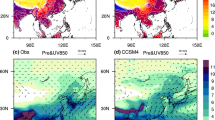Abstract
The surface air temperature (SAT) exhibits pronounced warming over West Antarctica in recent decades, especially in austral spring and winter. Using a 30-member ensemble of simulations by Community Earth System Model (CESM), two reanalysis datasets, and observed station data, this study investigates the relative contributions of internally generated low-frequency climate variability and externally forced climate change to the austral winter SAT trend in Antarctica. Although these simulations share the same external forcing, the SAT trends during 1979–2005 show large diversity among the individual members in the CESM ensemble simulations, suggesting that internally generated variability contributes a considerable part to the multidecadal SAT change in Antarctica. Quantitatively, the total forced contribution to the SAT (1979–2005) change is about 0.53 k/27 yr, and the internal variability can be strong enough to double or cancel the externally forced warming trend. A method called “dynamical adjustment” is utilized to further divide the forced response. We find both the forced thermodynamically-induced and the forced dynamically-induced SAT trends are positive over all the regions in Antarctica, with the regional mean values of 0.20 k /27 yr and 0.33 k/27 yr, respectively. The diversity of SAT trends among the simulations is closely linked to a Southern hemisphere Annular Mode (SAM)-like atmospheric circulation multidecadal change in the Southern Hemisphere. When there exists a positive–negative seesaw of pressure trend between Antarctica and the mid-latitudes, the SAT trend is positive over most of Antarctica but negative over the Antarctic Peninsula, and vice versa. The SAM-like atmospheric circulation multidecadal change mainly arises from atmospheric internal variability rather than remote tropical Sea Surface Temperature (SST).














Similar content being viewed by others
References
Alory G, Wijffels S, Meyers G (2007) Observed temperature trends in the Indian Ocean over 1960–1999 and associated mechanisms. Geophys Res Lett 34:471–473
Arblaster JM, Meehl GA (2006) Contributions of external forcings to southern annular mode trends. J Clim 19:2896–2905. https://doi.org/10.1175/Jcli3774.1
Berrisford P et al (2011) The ERA-Interim archive Version 2.0. ECMWF, Shinfield Park, Reading
Deser C, Phillips A, Bourdette V, Teng HY (2012) Uncertainty in climate change projections: the role of internal variability. Clim Dyn 38:527–546. https://doi.org/10.1007/s00382-010-0977-x
Deser C, Terray L, Phillips AS (2016) Forced and internal components of winter air temperature trends over North America during the Past 50 Years: mechanisms and implications. J. Climate 29:160107131720009
Ding QH, Steig EJ, Battisti DS, Kuttel M (2011) Winter warming in West Antarctica caused by central tropical Pacific warming. Nat Geosci 4:398–403. https://doi.org/10.1038/Ngeo1129
Fogt RL, Perlwitz J, Monaghan AJ, Bromwich DH, Jones JM, Marshall GJ (2009) Historical SAM variability Part II: twentieth-century variability and trends from reconstructions, observations, and the IPCC AR4. Models J Climate 22:5346–5275. https://doi.org/10.1175/2009jcli2786.1
Hawkins E, Sutton R (2009) The potential to narrow uncertainty in regional climate predictions. Bull Amer Meteorol Soc 90:333–337
Hawkins E, Sutton R (2011) The potential to narrow uncertainty in projections of regional precipitation change. Clim Dyn 37:407–418. https://doi.org/10.1007/s00382-010-0810-6
Hu K, Huang G, Xie S-P (2018) Assessing the internal variability in multi-decadal trends of summer surface air temperature over East Asia with a large ensemble of GCM simulations. Clim Dyn. https://doi.org/10.1007/s00382-018-4503-x
Ivy DJ, Hilgenbrink C, Kinnison D, Plumb RA, Sheshadri A, Solomon S, Thompson DWJ (2017) Observed changes in the Southern Hemispheric circulation in May. J Clim 30:527–527. https://doi.org/10.1175/Jcli-D-16-0394.1
Kay JE et al (2015) The community earth system model (CESM) large ENSEMBLE project a community resource for studying climate change in the presence of internal climate variability bull. Amer Meteorol Soc 96:1333–1349. https://doi.org/10.1175/bams-d-13-00255.1
Lehner F et al (2020) Partitioning climate projection uncertainty with multiple large ensembles and CMIP5/6. Earth Syst Dynam 11:491–508. https://doi.org/10.5194/esd-11-491-2020
Li X, Holland DM, Gerber EP, Yoo C (2014) Impacts of the north and tropical Atlantic Ocean on the Antarctic Peninsula and sea ice. Nature 505:538. https://doi.org/10.1038/nature12945
Li XC, Holland DM, Gerber EP, Yoo C (2015) Rossby waves mediate impacts of tropical oceans on west antarctic atmospheric circulation in Austral Winter. J Clim 28:8151–8164. https://doi.org/10.1175/Jcli-D-15-0113.1
Marsh DR, Mills MJ, Kinnison DE, Lamarque J-F, Calvo N, Polvani LM (2013) Climate Change from 1850 to 2005 Simulated in CESM1(WACCM). J Climate 26:7372–7391. https://doi.org/10.1175/jcli-d-12-00558.1
Raphael MN et al (2016) The amundsen sea low variability Change, and Impact on Antarctic Climate. Bull Amer Meteorol Soc 97:111–121. https://doi.org/10.1175/bams-d-14-00018.1
Rienecker MM et al (2011) MERRA: NASA's modern-era retrospective analysis for research and applications. J Climate 24:2724–2748. https://doi.org/10.1175/jcli-d-11-00015.1
Schneider DP, Deser C (2018) Tropically driven and externally forced patterns of Antarctic sea ice change: reconciling observed and modeled trends. Clim Dyn 50:4599–4618. https://doi.org/10.1007/s00382-017-3893-5
Schneider DP, Deser C, Okumura Y (2012) An assessment and interpretation of the observed warming of West Antarctica in the austral spring. Clim Dyn 38:323–347. https://doi.org/10.1007/s00382-010-0985-x
Seviour WJM, Gnanadesikan A, Waugh DW (2016) The transient response of the southern ocean to stratospheric ozone depletion. J Clim 29:7383–7396. https://doi.org/10.1175/Jcli-D-16-0198.1
Takaya K, Nakamura H (2001) A formulation of a phase-independent wave-activity flux for stationary and migratory quasigeostrophic eddies on a zonally varying basic flow. J Atmos Sci 58(6):608–627
Taylor KE, Stouffer RJ, Meehl GA (2012) An overview of Cmip5 and the experiment design. Bull Amer Meteorol Soc 93:485–498. https://doi.org/10.1175/Bams-D-11-00094.1
Thompson DWJ, Solomon S, Kushner PJ, England MH, Grise KM, Karoly DJ (2011) Signatures of the Antarctic ozone hole in Southern Hemisphere surface climate change. Nat Geosci 4:741. https://doi.org/10.1038/ngeo1296
Turner J et al (2004) The SCAR READER project: toward a high-quality database of mean antarctic meteorological observations. J Clim 17:2890–2898. https://doi.org/10.1175/1520-0442(2004)017%3C2890:tsrpta%3E2.0.co;2
Wallace JM, Deser C, Smoliak BV, Phillips AS (2015) Attribution of climate change in the presence of internal variability. In: climate change: multidecadal and beyond. World Scientific, pp 1–29 https://doi.org/10.1142/9789814579933_0001
Wallace JM, Fu Q, Smoliak BV, Lin P, Johanson CM (2012) Simulated versus observed patterns of warming over the extratropical Northern Hemisphere continents during the cold season. P Natl Acad Sci USA 109:14337–14342. https://doi.org/10.1073/pnas.1204875109
Acknowledgements
The authors would like to thank Xichen Li and Renguang Wu for many useful discussions. We also thank Letian Gu for reviewing a draft of this manuscript and Ruyu Gan for sharing the CESM1 dataset. The study is jointly supported by the National Key R&D Program of China (2018YFA0605904 and 2019YFA0606703), the Strategic Priority Research Program of Chinese Academy of Sciences (XDA20060502), the National Natural Science Foundation of China (41425086, 41831175, 41661144016, 41706026, 41506003, and 41731173), and Key Deployment Project of Centre for Ocean Mega-Research of Science, Chinese Academy of Sciences (COMS2019Q03).
Author information
Authors and Affiliations
Corresponding authors
Ethics declarations
Conflict of interest
The authors declare no conflict of interests.
Additional information
Publisher's Note
Springer Nature remains neutral with regard to jurisdictional claims in published maps and institutional affiliations.
Rights and permissions
About this article
Cite this article
Wang, Y., Huang, G. & Hu, K. Internal variability in multidecadal trends of surface air temperature over antarctica in austral winter in model simulations. Clim Dyn 55, 2835–2847 (2020). https://doi.org/10.1007/s00382-020-05412-1
Received:
Accepted:
Published:
Issue Date:
DOI: https://doi.org/10.1007/s00382-020-05412-1




